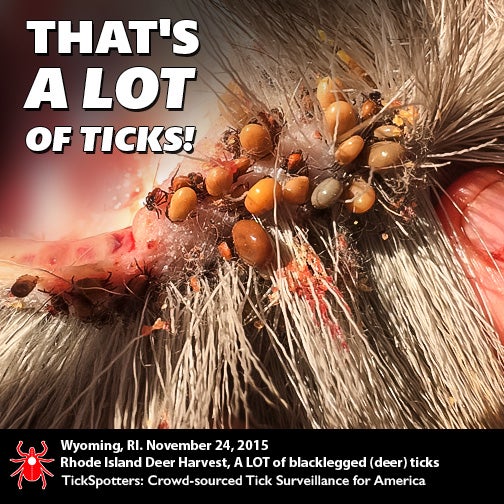“OH LOOK…There’s a deer in the backyard,” I hear my wife exclaim with glee and awe. “OH CRAP”, I grumble as I run to pull on boots and then dash outside to chase it away, all the while wondering how many more of my much-prized plants this unwanted moocher has destroyed. Backyard deer seem to evoke this type of love/hate relationship.
It’s not that I don’t like seeing deer, I just wish they wouldn’t eat my plants. And then there’s the tick thing, too. Deer are the main source of blood, the ‘reproductive’ hosts if you will, for several species of ticks increasing in numbers all across America. Blacklegged (deer) ticks, Lone Star ticks, Gulf Coast ticks, western blacklegged ticks—all of these ticks depend mainly on blood meals from deer to nourish the adult female-stage tick, allowing each one that engorges to develop and then lay thousands of eggs. As deer populations increase, especially in areas and landscapes closer and closer to where people live, tick populations also have increased. We’ve estimated that in Rhode Island, every deer every year feeds enough female deer ticks that then go on to lay eggs and hatch out nearly a half million new ticks. EVERY DEER, EVERY YEAR! — THAT’S A LOT OF TICKS!

Deer are nothing if not adaptable. Human demographics over the ‘50s, 60’s, 70’s and 80’s witnessed a movement out of cities and into less-crowded, peaceful rural settings, where there was only joy living with nature. At first, deer, as one part of nature, bolted for the hills…for a while…but as more development turned forests and farmland into suburbs, the deer just ran out of places to go. Instead, it seems they adopted an “if you can’t beat ‘em, join ‘em” existence, learning to actually thrive in the patchwork mosaic of smaller woodlots, parklands and other domestic settings. Now, some of the joy of “country” living has been diminished, and it’s not so much about eaten landscape plants but more the real public health crisis associated with ticks and the increasing array of germs that ticks portal from wildlife populations to people and pets. Those complex relationships could be the subject matter for whole other sets of stories.
But back to the deer…most people would be surprised at what goes on nature-wise just beyond their view of the edge of their property. Like me, you may occasionally or even frequently find munched-down hostas, lilies and tulips, or even see a deer or two in your yard. I’ve seen as many as 4 at a time. But I was shocked and surprised recently when a friend and former student, Hunter Jim, set up a tree stand and trail camera by the stonewall at the back of my property. He showed me some pictures. Talk about wildlife…we’re talking Bear Grylls-type close encounters. On one early morning sit, Jim reported that while I had seen one deer in the yard, from his tree stand he counted 12, all frolicking just beyond the tree line. At different times, his camera revealed bucks sparring, a parade of does and skippers, foxes and curious coyotes, and even a pair of chubby raccoons. During one 3 day period in early November, his camera had snapped over 120 images.
So, Houston…we’ve got a problem! It seems from all of this little wonder why we live in a “more ticks in more places” spot, and maybe you do, too. Viable solutions are likely to be a challenge—for individuals and communities dealing with the tickborne disease threat. Increasing deer harvest rates, deer culls, sharpshooters, 8 foot high fences, 4-Posters, deer repellents–these are all strategies being proposed for suppressing tick reproduction by reducing ticks access to blood, or deer access to close human proximity. Suburban deer management is challenging; innovative programs that match hunters with homeowners, and that encourage antlerless deer harvesting are becoming more than an idea now in many places. But measuring and realizing success from such programs is likely a longer term task requiring patience and persistence. In the meantime, TickEncounter will continue to educate and empower people in situations just like mine—plagued with backyard deer—to adopt TickSmart preventive behaviors and adapt to living in a ticky world.
